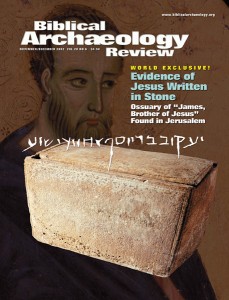Epigraphy—and the Lab—Say It’s Genuine
Sidebar to: Burial Box of James the Brother of Jesus
When an inscription appears on the antiquities market or in a private collection, as in the case of the extraordinary inscription discussed in the accompanying article, the first question an epigrapher (a specialist in ancient inscriptions) must answer is: Is it genuine or a fake?
To establish authenticity, we start with the object itself and then the inscription on it. Do they together and separately fit what we know from excavations and from other inscriptions?
Also, after more than 30 years of working with Hebrew, Phoenician and Aramaic inscriptions, one develops a “feel,” a first reaction when inspecting a new inscription. Does it fit what we already know from many other inscriptions or is it problematic?
This first feeling is important but of course needs to be checked by a detailed examination of the object and of the inscription, both with a magnifying glass (with a magnifying power of at least 10) and, if possible, with a binocular microscope (with a 50 to 100 magnifying power). Does the engraving have any signs of modern edges? Is the patina, the thin covering on the surface caused by age, firmly attached?
Already a library member? Log in here.
Institution user? Log in with your IP address.

